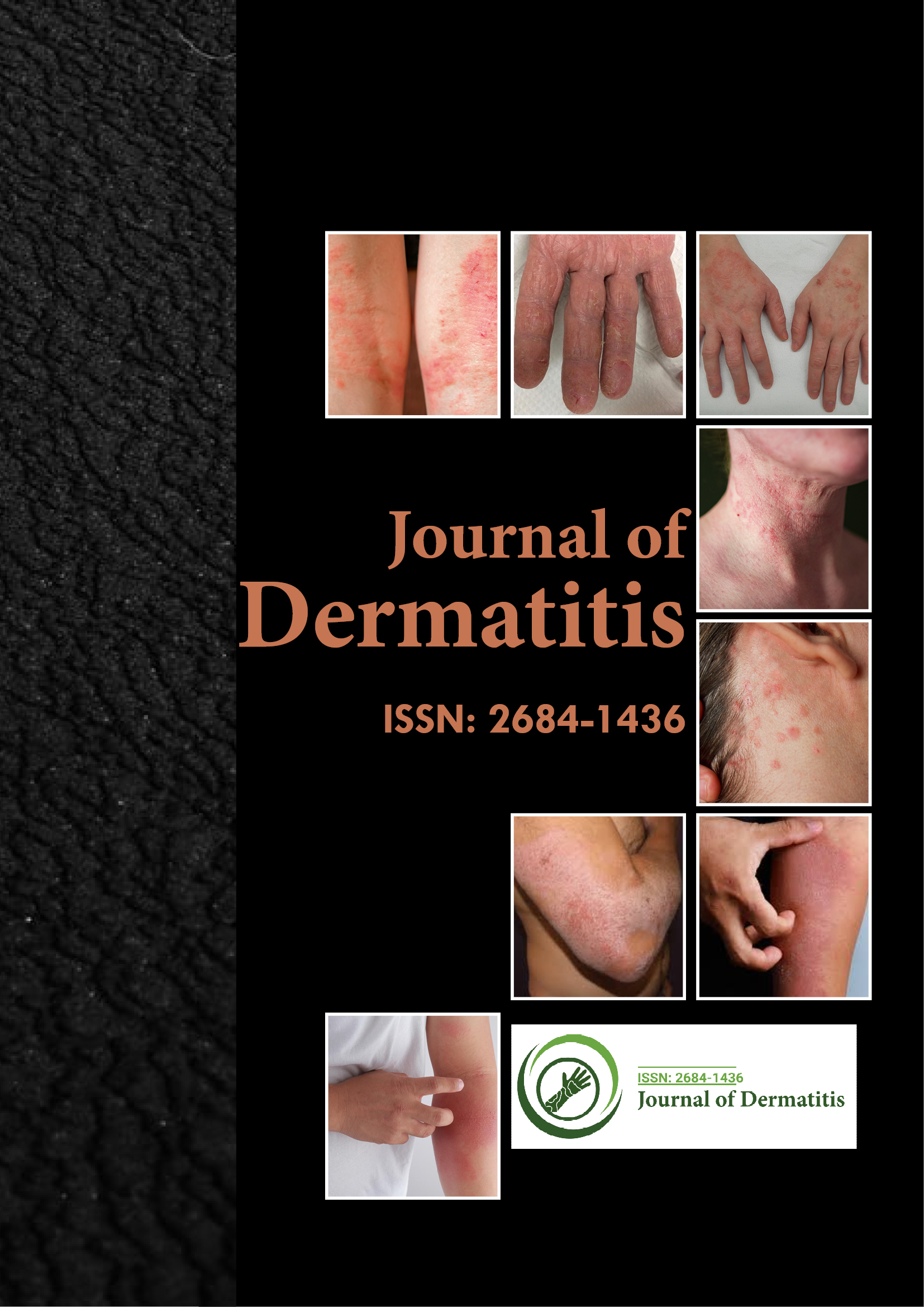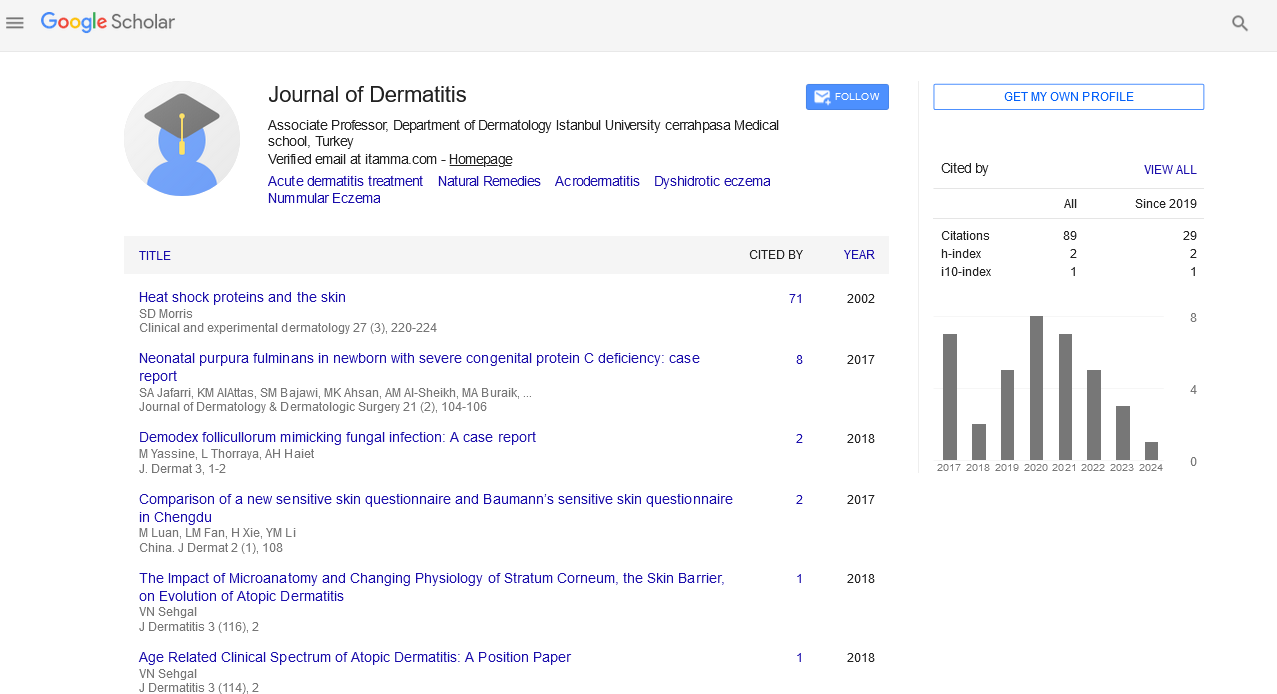Indexed In
- RefSeek
- Hamdard University
- EBSCO A-Z
- Euro Pub
- Google Scholar
Useful Links
Share This Page
Journal Flyer

Open Access Journals
- Agri and Aquaculture
- Biochemistry
- Bioinformatics & Systems Biology
- Business & Management
- Chemistry
- Clinical Sciences
- Engineering
- Food & Nutrition
- General Science
- Genetics & Molecular Biology
- Immunology & Microbiology
- Medical Sciences
- Neuroscience & Psychology
- Nursing & Health Care
- Pharmaceutical Sciences
Short Communication - (2024) Volume 9, Issue 1
Treatment Approaches for Nummular Dermatitis
Ranina Thiluna*Received: 02-Mar-2024, Manuscript No. JOD-24-26060; Editor assigned: 05-Mar-2024, Pre QC No. JOD-24-26060 (PQ); Reviewed: 21-Mar-2024, QC No. JOD-24-26060; Revised: 27-Mar-2024, Manuscript No. JOD-24-26060 (R); Published: 05-Apr-2024, DOI: 10.35248/2684-1436.24.9.237
Description
The inflammatory skin ailment known as nummal dermatitis or eczema is typified by the appearance of distinct round-to-oval erythematous plaques (nummal refers to round or "coin shaped"). Nummular dermatitis has been used to describe a distinct condition in addition to the lesion shape observed in other disorders, including asteatotic eczema, contact dermatitis, and atopic dermatitis. The focus of this discussion is the illness entity that has been covered in the literature. There have been various names for eczema, such as discoid and orbicular [1-3].
Nummular eczema was initially identified by Deverigie in 1857 as coin-shaped lesions on the upper extremities. Since then, reports of it have appeared on all body parts and in all age groups; nevertheless, the upper and lower extremities are the most common locations. Papules are the beginnings of lesions, usually developing into plaques. Scales are common in them. Early lesions may have vesicles containing serous exudate strewn across them. Severe itching is a common symptom of nummulular eczema. There are many known triggering causes, including dry skin, contact allergies, cold weather, poor diet, and psychological stress [4-6].
Skin hydration is the most important component of nummular eczema treatment. Using hypoallergenic, fragrance-free creams, lotions, or ointments is the initial step in therapy. The major objectives of treatment are to treat any infections, reduce inflammation, rebuild the epidermal lipid barrier, and rehydrate the skin. Wetting the skin beforehand facilitates the optimum absorption of emollients and drugs.
Warm or cold baths or showers relieve skin irritation and replenish moisture; people can also use a light soap or liquid cleaner. After patting dry, moisturizers should be applied to skin that is still damp. The "soak-and-smear" treatment protocol involves soaking in plain water for 20 minutes every night, then applying petrolatum or steroid ointment on damp skin. Additionally, it suggests modifying one's cleaning regimen to restrict the use of soap to the groyne and axilla. In one trial, 27 out of 28 patients with refractory chronic pruritic eruptions exhibited better than 90% improvement when the regimen was followed exactly as prescribed [7-10].
Using wet wraps is often advantageous. To do this, moisturize the skin by soaking it in lukewarm water for a minimum of 10 minutes. After applying a generous amount of petrolatum or steroid ointment, the patient is wrapped in a non-breathable sauna suit or damp pajamas for an hour. It is possible to cover up tiny areas of participation with plastic wrap. This process can be repeated five or six times a day using petroleum jelly. It is important to utilize prescription steroid treatments with caution as overuse can induce skin thinning, stride abnormalities, and in rare instances, systemic steroid absorption significant enough to impact the hypothalamic-pituitary-adrenal axis.
Steroids are the most often used therapy for reducing inflammation. Lesions that are less erythematous and itchier can be treated with low-potency (class III-VI) steroids. When treating extremely inflamed lesions with significant erythema, vesicles, and pruritus, high-potency (class I-II) preparations are required. The steroid-containing ointment is applied immediately (without drying), after occlusion and/or presoaking in a tub of plain water. This increases the medication's capacity to penetrate the skin.
Ointments are usually more effective than creams because they are more occlusive, form a barrier between the skin and the external environment, and better retain water in the skin. However, patients may be more willing to use a cream formulation; education and communication play a major role in patient compliance. In situations where there are severe and broad eruptions, steroids can be given intravenously, intramuscularly, or orally. Tar formulations are helpful in lowering inflammation, especially in older, thicker, scaly plaques. Topical immune modulators such as tacrolimus and pimecrolimus also reduce inflammation. These are often started a few days after the topical steroid to reduce the chance of a burning sensation when applied to very irritated skin.
References
- Leyden JJ. Therapy for acne vulgaris. N Engl J Med. 1997;336(16):1156-1162.
[Crossref] [Google Scholar] [PubMed]
- Conforti C. Carbon peeling laser treatment to improve skin texture, pores and acne lesions: A retrospective study. Medicina.58(11):1668 (2022).
[Crossref] [Google Scholar] [PubMed]
- Pathmarajah P, Peterknecht E, Cheung K, Elyoussfi S, Muralidharan V, Bewley A, et al. Acne vulgaris in skin of color: A systematic review of the effectiveness and tolerability of current treatments. J Clin Aesthet Dermatol.15(11):43 (2022).
[Google Scholar] [PubMed]
- Alexis A. Racial/Ethnic variations in acne: A practical algorithm for treatment and maintenance, including skincare recommendations for skin of color patients with acne. J Drugs Dermatol. 21(11):s13223-s13214 (2022).
[Google Scholar] [PubMed]
- Rehan ST, Khan Z, Abbas S, Imran L, Munir S, Tahir MJ, et al. Role of topical spironolactone in the treatment of acne: A systematic review of clinical trials-Does this therapy open a path towards favorable outcomes?. J Dermatol. 2023;50(2):166-174.
[Crossref] [Google Scholar] [PubMed]
- Kao HJ. Extracellular electrons transferred from honey probiotic Bacillus circulans inhibits inflammatory acne vulgaris. Sci Rep.2022;12(1):19217.
[Crossref] [Google Scholar] [PubMed]
- Schachner LA, Alexis AF, Andriessen A, Berson D, Gold M, Goldberg DJ, et al. Insights into acne and the skin barrier: Optimizing treatment regimens with ceramide‐containing skincare. J Cosmet Dermatol. 2023;22(11):2902-2909.
[Crossref] [Google Scholar] [PubMed]
- Alexis AF. An algorithm for the management of atopic dermatitis in people with skin of color. J Drugs Dermatol. 2023;22(8):SF386361s3-SF386361s10.
[Google Scholar] [PubMed]
- Kanokvalai Kulthanan MD. Recommendations for using over-the-counter products as adjunctive acne care in asian phototypes: Improving treatment outcomes and managing side effects. J Drugs Dermatol. 20(11):1213-1221 (2021).
[Crossref] [Google Scholar] [PubMed]
- Callender VD. Effects of topical retinoids on acne and post-inflammatory hyperpigmentation in patients with skin of color: a clinical review and implications for practice. Am J Clin Dermatol. 2022;23(1):69-81.
[Crossref] [Google Scholar] [PubMed]
Citation: Thiluna R (2024) Treatment Approaches for Nummular Dermatitis. J Dermatitis. 9:237.
Copyright: © 2024 Thiluna R. This is an open-access article distributed under the terms of the Creative Commons Attribution License, which permits unrestricted use, distribution, and reproduction in any medium, provided the original author and source are credited.

